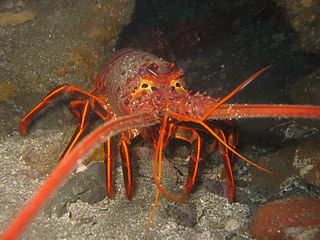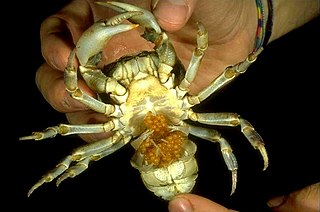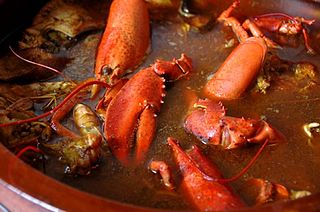
Crayfish are freshwater crustaceans resembling small lobsters. In some locations, they are also known as crawfish, craydids, crawdaddies, crawdads, freshwater lobsters, mountain lobsters, rock lobsters, mudbugs, baybugs or yabbies. Taxonomically, they are members of the superfamilies Astacoidea and Parastacoidea. They breathe through feather-like gills. Some species are found in brooks and streams, where fresh water is running, while others thrive in swamps, ditches, and paddy fields. Most crayfish cannot tolerate polluted water, although some species, such as Procambarus clarkii, are hardier. Crayfish feed on animals and plants, either living or decomposing, and detritus.

Lobsters are a family of large marine crustaceans.

Spiny lobsters, also known as langustas, langouste, or rock lobsters, are a family (Palinuridae) of about 60 species of achelate crustaceans, in the Decapoda Reptantia. Spiny lobsters are also, especially in Australia, New Zealand, Ireland, South Africa, and The Bahamas, called crayfish, sea crayfish, or crawfish, terms which elsewhere are reserved for freshwater crayfish.

The American lobster is a species of lobster found on the Atlantic coast of North America, chiefly from Labrador to New Jersey. It is also known as Atlantic lobster, Canadian lobster, true lobster, northern lobster, Canadian Reds, or Maine lobster. It can reach a body length of 64 cm (25 in), and a mass of over 20 kilograms (44 lb), making it not only the heaviest crustacean in the world, but also the heaviest of all living arthropod species. Its closest relative is the European lobster Homarus gammarus, which can be distinguished by its coloration and the lack of spines on the underside of the rostrum. American lobsters are usually bluish green to brown with red spines, but several color variations have been observed.

Homarus gammarus, known as the European lobster or common lobster, is a species of clawed lobster from the eastern Atlantic Ocean, Mediterranean Sea and parts of the Black Sea. It is closely related to the American lobster, H. americanus. It may grow to a length of 60 cm (24 in) and a mass of 6 kilograms (13 lb), and bears a conspicuous pair of claws. In life the lobsters are blue, only becoming "lobster red" on cooking. Mating occurs in the summer, producing eggs which are carried by the females for up to a year before hatching into planktonic larvae. Homarus gammarus is a highly esteemed food, and is widely caught using lobster pots, mostly around the British Isles.

A lobster roll is a dish native to New England. It is made of lobster meat served on a grilled hot dog-style bun. The filling may also contain butter, lemon juice, salt, black pepper, with variants made in some parts of New England replacing the butter with mayonnaise. Other versions may contain diced celery or scallion. Potato chips or french fries are the typical sides.

Red Lobster Hospitality LLC is an American casual dining restaurant chain headquartered in Orlando, Florida. The company has operations across most of the United States and Canada, as well as in China, Ecuador, Guam, Hong Kong, Japan, Malaysia, Mexico, Philippines, Puerto Rico, Turkey and the United Arab Emirates; as of June 23, 2020, the company had 719 locations worldwide. Golden Gate Capital became Red Lobster's parent company when it was acquired from Darden Restaurants on July 28, 2014. Seafood supplier Thai Union acquired a 25 percent stake in the company in 2016 for a reported $575 million, and in 2020 purchased the remaining portion from GGC.

Reptantia is a clade of decapod crustaceans named in 1880 which includes lobsters, crabs and many other well-known crustaceans.

Pleocyemata is a suborder of decapod crustaceans, erected by Martin Burkenroad in 1963. Burkenroad's classification replaced the earlier sub-orders of Natantia and Reptantia with the monophyletic groups Dendrobranchiata (prawns) and Pleocyemata. Pleocyemata contains all the members of the Reptantia, as well as the Stenopodidea, and Caridea, which contains the true shrimp.

Lobsters are widely fished around the world for their meat. They are often hard to catch in large numbers, but their large size can make them a profitable catch. Although the majority of the targeted species are tropical, the majority of the global catch is in temperate waters.

Squat lobsters are dorsoventrally flattened crustaceans with long tails held curled beneath the cephalothorax. They are found in the two superfamilies Galatheoidea and Chirostyloidea, which form part of the decapod infraorder Anomura, alongside groups including the hermit crabs and mole crabs. They are distributed worldwide in the oceans, and occur from near the surface to deep sea hydrothermal vents, with one species occupying caves above sea level. More than 900 species have been described, in around 60 genera. Some species form dense aggregations, either on the sea floor or in the water column, and a small number are commercially fished.

A lobster trap or lobster pot is a portable trap that traps lobsters or crayfish and is used in lobster fishing. In Scotland, the word creel is used to refer to a device used to catch lobsters and other crustaceans. A lobster trap can hold several lobsters. Lobster traps can be constructed of wire and wood, or metal and netting or rigid plastic. An opening permits the lobster to enter a tunnel of netting or other one-way device. Pots are sometimes constructed in two parts, called the "chamber" or "kitchen", where there is bait, and exits into the "parlour", which prevents escape. Lobster pots are usually dropped to the sea floor, one or more at a time, sometimes up to 40 or more, and are marked by a buoy so they can be picked up later.

Slipper lobsters are a family (Scyllaridae) of about 90 species of achelate crustaceans, in the Decapoda clade Reptantia, found in all warm oceans and seas. They are not true lobsters, but are more closely related to spiny lobsters and furry lobsters. Slipper lobsters are instantly recognisable by their enlarged antennae, which project forward from the head as wide plates. All the species of slipper lobsters are edible, and some, such as the Moreton Bay bug and the Balmain bug are of commercial importance.

Scyllarides latus, the Mediterranean slipper lobster, is a species of slipper lobster found in the Mediterranean Sea and in the eastern Atlantic Ocean. It is edible and highly regarded as food, but is now rare over much of its range due to overfishing. Adults may grow to 1 foot (30 cm) long, are camouflaged, and have no claws. They are nocturnal, emerging from caves and other shelters during the night to feed on molluscs. As well as being eaten by humans, S. latus is also preyed upon by a variety of bony fish. Its closest relative is S. herklotsii, which occurs off the Atlantic coast of West Africa; other species of Scyllarides occur in the western Atlantic Ocean and the Indo-Pacific. The larvae and young animals are largely unknown.

Scyllarides is a genus of slipper lobsters.

Arctides is a genus of slipper lobsters, containing three species. The largest of these, A. antipodarum, has a carapace up to 100 millimetres (3.9 in) long, and is found off south-eastern Australia and parts of New Zealand. The other two species are smaller, at up to 70 millimetres (2.8 in) carapace length; A. guineensis is found in an area similar to the Bermuda Triangle; A. regalis is widely distributed in the Indo-Pacific, from the Mascarene Islands to Hawaii and Easter Island.
Arctides guineensis is a species of slipper lobster which lives in the Bermuda Triangle. It is known in Bermuda as the small Spanish lobster, a name which is also favoured by the FAO.

Lobster stew is found in a variety of cuisines. Two famous versions are Menorcan caldera de llagosta and Maine lobster stew.

The Lobster is a 2015 European surreal black comedy dystopian film directed, co-written, and co-produced by Yorgos Lanthimos, co-produced by Ceci Dempsy, Ed Guiney, and Lee Magiday, and co-written by Efthimis Filippou. In the film, single people are given 45 days to find romantic partners or otherwise be turned into animals. It stars Colin Farrell and Rachel Weisz as a man and woman who attempt to form a relationship. The film is a co-production by Ireland, the United Kingdom, Greece, France and the Netherlands.

Arctides regalis is a species of tropical lobster. Its common name is royal Spanish lobster and it is known as ula-papapa in Hawaii.














